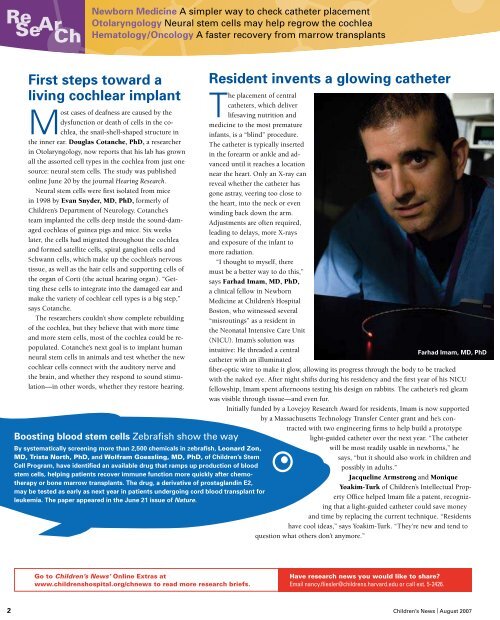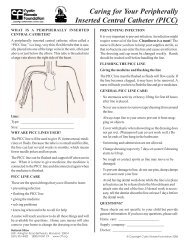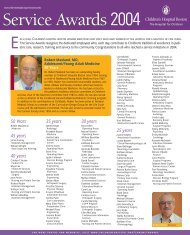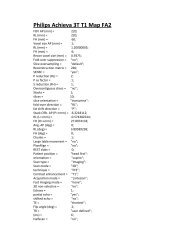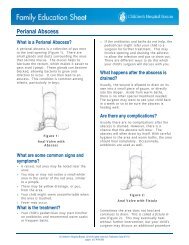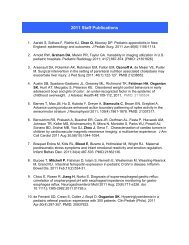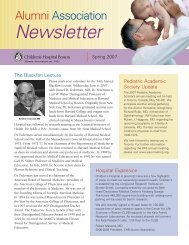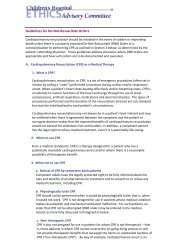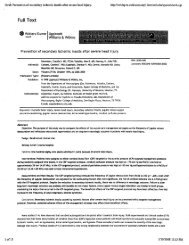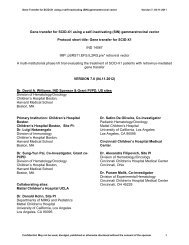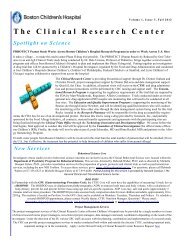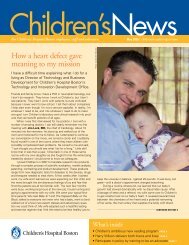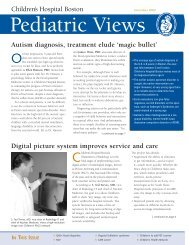Mission: Possible - Children's Hospital Boston
Mission: Possible - Children's Hospital Boston
Mission: Possible - Children's Hospital Boston
You also want an ePaper? Increase the reach of your titles
YUMPU automatically turns print PDFs into web optimized ePapers that Google loves.
Newborn Medicine A simpler way to check catheter placement<br />
Otolaryngology Neural stem cells may help regrow the cochlea<br />
Hematology/Oncology A faster recovery from marrow transplants<br />
First steps toward a<br />
living cochlear implant<br />
Most cases of deafness are caused by the<br />
dysfunction or death of cells in the cochlea,<br />
the snail-shell-shaped structure in<br />
the inner ear. Douglas Cotanche, PhD, a researcher<br />
in Otolaryngology, now reports that his lab has grown<br />
all the assorted cell types in the cochlea from just one<br />
source: neural stem cells. The study was published<br />
online June 20 by the journal Hearing Research.<br />
Neural stem cells were first isolated from mice<br />
in 1998 by Evan Snyder, MD, PhD, formerly of<br />
Children’s Department of Neurology. Cotanche’s<br />
team implanted the cells deep inside the sound-damaged<br />
cochleas of guinea pigs and mice. Six weeks<br />
later, the cells had migrated throughout the cochlea<br />
and formed satellite cells, spiral ganglion cells and<br />
Schwann cells, which make up the cochlea’s nervous<br />
tissue, as well as the hair cells and supporting cells of<br />
the organ of Corti (the actual hearing organ). “Getting<br />
these cells to integrate into the damaged ear and<br />
make the variety of cochlear cell types is a big step,”<br />
says Cotanche.<br />
The researchers couldn’t show complete rebuilding<br />
of the cochlea, but they believe that with more time<br />
and more stem cells, most of the cochlea could be repopulated.<br />
Cotanche’s next goal is to implant human<br />
neural stem cells in animals and test whether the new<br />
cochlear cells connect with the auditory nerve and<br />
the brain, and whether they respond to sound stimulation—in<br />
other words, whether they restore hearing.<br />
Resident invents a glowing catheter<br />
The placement of central<br />
catheters, which deliver<br />
lifesaving nutrition and<br />
medicine to the most premature<br />
infants, is a “blind” procedure.<br />
The catheter is typically inserted<br />
in the forearm or ankle and advanced<br />
until it reaches a location<br />
near the heart. Only an X-ray can<br />
reveal whether the catheter has<br />
gone astray, veering too close to<br />
the heart, into the neck or even<br />
winding back down the arm.<br />
Adjustments are often required,<br />
leading to delays, more X-rays<br />
and exposure of the infant to<br />
more radiation.<br />
“I thought to myself, there<br />
must be a better way to do this,”<br />
says Farhad Imam, MD, PhD,<br />
a clinical fellow in Newborn<br />
Medicine at Children’s <strong>Hospital</strong><br />
<strong>Boston</strong>, who witnessed several<br />
“misroutings” as a resident in<br />
the Neonatal Intensive Care Unit<br />
(NICU). Imam’s solution was<br />
intuitive: He threaded a central<br />
Farhad Imam, MD, PhD<br />
catheter with an illuminated<br />
fiber-optic wire to make it glow, allowing its progress through the body to be tracked<br />
with the naked eye. After night shifts during his residency and the first year of his NICU<br />
fellowship, Imam spent afternoons testing his design on rabbits. The catheter’s red gleam<br />
was visible through tissue—and even fur.<br />
Initially funded by a Lovejoy Research Award for residents, Imam is now supported<br />
by a Massachusetts Technology Transfer Center grant and he’s con-<br />
tracted with two engineering firms to help build a prototype<br />
Boosting blood stem cells Zebrafish show the way<br />
light-guided catheter over the next year. “The catheter<br />
By systematically screening more than ,500 chemicals in zebrafish, Leonard Zon,<br />
will be most readily usable in newborns,” he<br />
MD, Trista North, PhD, and Wolfram Goessling, MD, PhD, of Children’s Stem<br />
says, “but it should also work in children and<br />
Cell Program, have identified an available drug that ramps up production of blood<br />
possibly in adults.”<br />
stem cells, helping patients recover immune function more quickly after chemotherapy<br />
or bone marrow transplants. The drug, a derivative of prostaglandin E ,<br />
may be tested as early as next year in patients undergoing cord blood transplant for<br />
leukemia. The paper appeared in the June 1 issue of Nature.<br />
Jacqueline Armstrong and Monique<br />
Yoakim-Turk of Children’s Intellectual Property<br />
Office helped Imam file a patent, recognizing<br />
that a light-guided catheter could save money<br />
and time by replacing the current technique. “Residents<br />
have cool ideas,” says Yoakim-Turk. “They’re new and tend to<br />
question what others don’t anymore.”<br />
Go to Children’s News’ Online Extras at<br />
www.childrenshospital.org/chnews to read more research briefs.<br />
Have research news you would like to share?<br />
Email nancy.fliesler@childrens.harvard.edu or call ext. 5-2426.<br />
Cheonil Kim, MD, attended medical<br />
school in Seoul, Korea, where he was<br />
born, but he knew that once he finished<br />
his degree, he wanted to practice medicine<br />
in the United States. But before he could<br />
leave Korea, he had to serve in the medical<br />
branch of its army. “It was just like that show<br />
M*A*S*H,” he remembers, laughing.<br />
After the army, Kim made the move overseas<br />
and in 1980 began his fellowship at Children’s<br />
<strong>Hospital</strong> <strong>Boston</strong>. From the start, he found<br />
it to be a great fit. “I liked it and they liked<br />
me,” he says. “The families make you feel so<br />
good about working here.” One of the biggest<br />
differences he noticed between American<br />
and Korean hospitals was how patient-doctor<br />
relationships worked. “People are more skeptical<br />
of health professionals in Korea,” he says.<br />
“Families here are positive because they trust<br />
in you—and the institution. That motivates me<br />
to give 100 percent.”<br />
Kim trained in General Surgery for two<br />
years before he decided to make a switch to<br />
Gratitudes<br />
Children’s News | August 2007 www.childrenshospital.org<br />
The secret to his success<br />
DESTINATION:<br />
Children’s<br />
The following letter was sent to Jennifer Finn,<br />
general manager at Fitcorp.<br />
The Nussenbaum family<br />
South Korea<br />
il Kim, MD<br />
Anesthesiologist<br />
Anesthesia. “It takes a certain type of person to<br />
be a surgeon and that wasn’t me,” he says. But<br />
that hasn’t kept Kim out of the operating room<br />
(OR). As an OR director focusing on anesthesia<br />
during otolaryngologic (ears, nose and<br />
throat) surgeries, he ensures that the surgeries<br />
run smoothly, while acting as a liaison between<br />
surgeons, nurses, departments and families.<br />
Despite his success, Kim still considers his<br />
language barrier to be a big challenge. “I give<br />
professional talks, but it’s on a basic level of<br />
communication,” he says. “It helps that I’m<br />
in the medical field, especially at Children’s,<br />
since people really try to understand me in<br />
context, despite my mispronunciations.” He<br />
brushes up on his elocution from time to time<br />
with English lessons and gets a fair amount<br />
of practice talking to his three American-born<br />
sons. Kim considers himself a family man and<br />
attributes this to his heritage. “My cultural<br />
identity is pretty strong,” he says. “I’m very<br />
family-oriented and half of the food I eat is<br />
from my culture—I like the spice.” Although<br />
all of his sons are American, he says, “They<br />
have stronger cultural connections to Korea<br />
than I thought they would—their heritage is<br />
always on their minds, and that’s reflected in<br />
the food they eat.”<br />
Being bilingual has been useful to Kim when<br />
treating Korean-speaking patients over the<br />
years, and many departments have sought his<br />
Dear Jennifer,<br />
translation help. “Even if the family speaks<br />
basic English, they may need clear communication<br />
to feel comfortable. I’m proud to help,”<br />
he says.<br />
Kim knows that the decision he made<br />
decades ago to immigrate to the United States<br />
was the right one. “In Korea, the medical<br />
profession is about fame and prestige,” he says.<br />
“Those weren’t my goals and that’s not my<br />
style,” he says. “Here, it’s about respecting the<br />
individual and quality of care. People appreciate<br />
my work and my presence. I consider that<br />
success.”<br />
Five months ago my teenage son was hospitalized at Children’s<br />
<strong>Hospital</strong> <strong>Boston</strong>. What began as a simple case of mono turned into<br />
a serious illness that ultimately necessitated him having a bone<br />
marrow transplant. My wife and I spent four months at Children’s<br />
with our son, and we continue to return with him on an outpatient<br />
basis during the long recovery period.<br />
During my son’s hospitalization, I managed to set aside time every<br />
day to come to Fitcorp so that I could work out, shower, shave and<br />
try to clear my head. As difficult as this ordeal has been for me<br />
and my family, I cannot even begin to imagine what it would have<br />
been like had I not been able to retreat to Fitcorp. It is hard to put<br />
into words just how important it was to have your club available<br />
to me, even for this short time each day.<br />
I just wanted to thank you so much for making this resource<br />
available to me and other families of Children’s patients. It is a<br />
wonderful service that you provide to parents who must endure<br />
the nightmare of having a sick child.<br />
Cheonil Kim, MD<br />
Adam Nussenbaum


